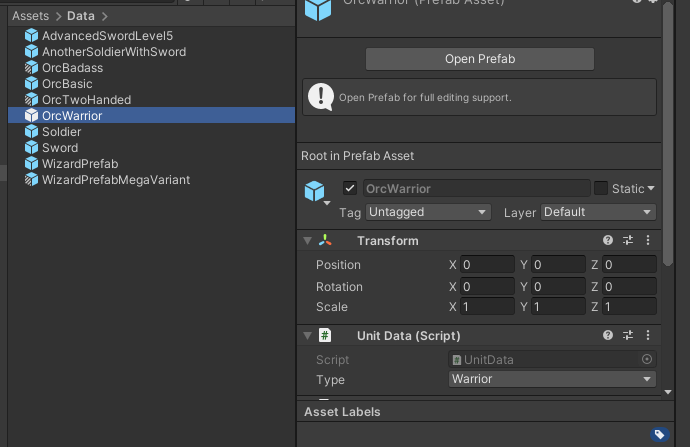

The Select button in the screenshot finds the prefab asset inside the Project window and highlights it for you. Any changes or additions you make to the prefab’s scripts or children here will automatically get saved to the prefab asset. You can either select the tiny right-facing arrow icon to the right of a prefab instance’s name in the Hierarchy, click the Open button seen on the screenshot above, or double-click the prefab asset in the Project window, and Unity will bring up a Scene View-like window containing only the prefab. The other way to modify a prefab is to enter Prefab Mode. Overriding a prefab to add a new child GameObject. Unity will list every difference between the source prefab asset and this prefab instance, which we can Revert or Apply, individually or all at once. If we need to make a quick change such as modifying some script values, then it’s usually easiest to tweak the value on an instance, then select the Overrides drop-down.

Now that we’ve created a prefab, let’s talk about updating the values on that prefab. If we want to create multiple instances of the prefab, then that’s easy - we can duplicate any instance that’s already in the scene, or we can drag the prefab asset from the Project window onto the Hierarchy or into the Scene View. Conversely, if you were to then delete the source prefab, then the object’s name in the Hierarchy will turn red to signify that its source prefab is missing.

The small icon for the object in the hierarchy will change to a blue cube and its name will turn blue - this is an easy way to tell which objects in your scene are prefabs. Prefabs are held inside the Project window as prefab assets - to create one, drag any GameObject from the Hierarchy to the Project window - any attached scripts and child GameObjects will also be included in that prefab. Let’s talk about using prefabs in practice. The non-prefab alternative is to copy and paste a basic GameObject a bunch of times, but the big drawback is that changes to the original GameObject don’t get propagated to the copies. The powerful thing about prefabs is that we can create several instances of them and they’ll all be clones of the prefab, and any changes we make to the prefab will be propagated across each instance. Prefabs, at their core, are GameObjects with scripts, meshes, textures, materials, colliders and all manner of other Components attached with their variable values tweaked, and we are telling Unity: “I want to use this object, with these exact components and values, in my scene at least once”. If you’re not a programmer, the prefab is like a blueprint for a house which defines its layout, dimensions, positions of doors and windows, and so on the built houses themselves are instances of that blueprint which we can interact with. If you come from a programming background, you might find it useful to think of a prefab and its instances in the same way you think of a class and instances of that class. This tutorial was created with Unity 2019.3 in mind, but many of the concepts will apply to previous versions. In this tutorial, we’ll look at what other features prefabs have and some examples of how they might be used in your projects. We can also override some of the properties of a prefab in the editor, and those changes will be propagated to all instances of the prefab in your scene. The basic purpose of a prefab is to bundle up assets and behaviour into pre-defined units which can be cloned in-editor or at runtime, saving us the trouble of creating the individual components of a GameObject and binding them together whenever we want to clone something. Prefabs have been a core Unity feature since the very first release of the engine.


 0 kommentar(er)
0 kommentar(er)
